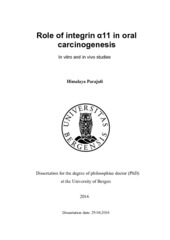| dc.contributor.author | Parajuli, Himalaya | en_US |
| dc.date.accessioned | 2016-05-04T11:36:15Z | |
| dc.date.available | 2016-05-04T11:36:15Z | |
| dc.date.issued | 2016-04-29 | |
| dc.identifier.isbn | 978-82-308-3342-1 | en_US |
| dc.identifier.uri | https://hdl.handle.net/1956/11974 | |
| dc.description.abstract | Cancer research has provided evidence for several advanced and better ways of treatment, helping the community for a better living. Nevertheless, for head and neck cancer there is still a long way to go for achieving an earlier and a more precise diagnosis and a better, more targeted and less toxic treatment plan, which would ensure a longer survival with a better quality of life for the patients. Research has shown, in the recent years that the tumour microenvironment is an important cluster of players for tumour progression and response to therapy, which can be used for patient stratification and for a better, more efficient therapy. Head and neck cancer is the eighth most common type of human cancer, squamous cell carcinoma being the most common variant. The number of head and neck cancer cases is increasing worldwide, but particularly in the low-income countries, and mainly for the cases limited to the oral cavity. As an oral cancer lesion progresses, directly or indirectly the environment around is affected, which either promote or try to resist the growth of the tumour. Nevertheless, the specific role of the various components of microenvironment and their importance for tumour prognosis and treatment are still not fully understood. The aim of this study was to determine the expression pattern and the role of integrin a11, a collagen receptor recently associated with the carcinoma associated fibroblast (CAF) phenotype, in oral cancer progression, in order to determine its potential as a biomarker and as a key player for oral carcinogenesis. The expression pattern of integrin a11 was characterized in patient tumour tissue samples both at protein and mRNA level, and compared with a-SMA, one of a previously established CAF marker of poor prognosis in oral and tongue carcinoma. Our results showed that integrin a11 was overexpressed in the stroma of head and neck cancer compared with normal mucosa and correlated positively with the expression of a-SMA. The differences obtained by analysing the expression of a-SMA at the invasive tumour front (ITF) versus tumour centre (TC) pinpointed the importance of selection of relevant tumour region, when evaluating a potential biomarker. Furthermore, the putative biological role of integrin a11 for the development of oral carcinoma was studied in integrin all knockout (KO) SCID mice versus wild type (WT) SCID mice, by exposing them to a chemical carcinogen (4NQO) in drinking water. An important role for a11 in the transition from a hyper proliferative stage till a malignant, invasive stage was indicated by the fact that the tumours formed in the KO mice took longer to develop from the oral papillomas and were smaller when compared to the tumours formed in the WT mice. To study the role of a11 in human oral carcinogenesis, integrin a11 expression was also knocked-down in human oral CAFs by using shRNA constructs. CAFs with knocked-down integrin a11 showed lesser migration, were less efficient in remodelling the collagen matrix and supported a more shallow cancer cell invasion in 3D organotypic cultures when compared to control cells. For in vivo studies, a microenviromentally-induced oral cancer mice model was developed. The use of a luciferase transfected oral dysplastic cell line assisted in the establishment of a non-invasive, yet consistent and more sensitive method of assessment of intraoral tumour progression. Co-injection of integrin a11 knocked-down CAFs the luciferase expressing dysplastic cell line induced smaller and less vascularized tumours than the control CAFs. Taken together, the results of this work showed that expression of integrin a11 in oral cancer is increased at various levels in the stroma of oral cancer and plays a biological role for tumour progression both by directly affecting the invasive properties of oral cancer cells and by providing a pro-angiogenesis microenvironment. | en_US |
| dc.language.iso | eng | eng |
| dc.publisher | The University of Bergen | eng |
| dc.relation.haspart | Paper I: Himalaya Parajuli, Muy-Teck Teh, Siren Abrahamsen, Ingrid Christoffersen, Evelyn Neppelberg, Stein Lybak, Tarig Osman, Anne Chr. Johannessen, Donald Gullberg, Kathrine Skarstein, Daniela Elena Costea. Integrin al I is overexpressed by tumour stroma of head and neck squamous cell carcinoma and correlates positively with a-SMA expression. Submited manuscript. This article is not available in BORA. | en_US |
| dc.relation.haspart | Paper II: Salwa Suliman, Himalaya Parajuli, Yang Sun, Anne Christine Johannessen, Anna Finne-Wistrand, Emmet McCormack, Kamal Mustafa, Daniela Elena Costea. Establishment of a bioluminescence model for microenvironmentally induced oral carcinogenesis with implications for screening bioengineered scaffolds. The article is available in BORA at: <a href="http://hdl.handle.net/1956/11721" target="blank">http://hdl.handle.net/1956/11721</a> | en_US |
| dc.relation.haspart | Paper III: Himalaya Parajuli, Dipak Sapkota, Saroj Rajthala, Ning Lu, Tarig Osman, Salwa Suliman, Emmet Mc Cormack, Evelyn Neppelberg, Stein Lybak, Per Gunnar Liavaag, Anne Christine Johannessen, Donald Gullberg, Daniela Elena Costea. Stromal integrin al I regulates growth and invasion of oral squamous cell carcinoma. Manuscript. This article is not available in BORA. | en_US |
| dc.title | Role of integrin α11 in oral carcinogenesis. In vitro and in vivo studies | en_US |
| dc.type | Doctoral thesis | |
| dc.rights.holder | Copyright the author. All rights reserved. | |
